Clinical Factors Associated with Very Severe Obstructive Sleep Apnea in Mongolian Patients: A Case-Control Study
DOI:
https://doi.org/10.24079/cajms.2021.09.002Keywords:
Obstructive Sleep Apnea, Case-Control Study, Apnea-Hypopnea IndexAbstract
Objectives: To determine risk factors and clinical characteristics of obstructive sleep apnea patients (OSA) according to the severity of the value of AHI ≥ 60 (Apnea-Hypopnea Index). Methods: A hospital-based, case-control study, December 2018 - 2020. Patients were grouped by severity of AHI as moderate, severe, and very severe. Results: Of 103 male cases, 52 were very severe obstructive sleep apnea (vsOSA). The control group consisted of 16 moderate OSA (mOSA) and 35 severe OSA (sOSA) patients. The case group consisted of 52 vsOSA patients. The average age was 48.7 ± 12.6. There was statistically significant increased body mass index (p < 0.003), systolic blood pressure, and abdominal circumference (p < 0.006) in the vsOSA group. Moreover, on polysomnography there was less deep sleep (p < 0.004), a greater arousal index (p < 0.000), higher apnea-hypopnea index (p < 0.000), and higher night systole pressure (p < 0.010). According to a bivariate analysis, abdominal circumferences were the variable with the closest association to the vsOSA group (crude OR: 9.14, p > 0.004), followed by decreased maximum saturation of O2 (crude OR: 6.6, p > 0.451). Conclusion: Of male OSA patients, 50.1% have vsOSA (AHI > 60) and most of them were obese and suffered from high blood pressure. Lower levels of O2 saturation and increased abdominal and neck circumferences were significant risk factors for the very severe obstructive sleep apnea group.
Downloads
195
Downloads
Published
How to Cite
Issue
Section
License
Copyright (c) 2021 Mongolian National University of Medical Sciences

This work is licensed under a Creative Commons Attribution-NonCommercial 4.0 International License.




